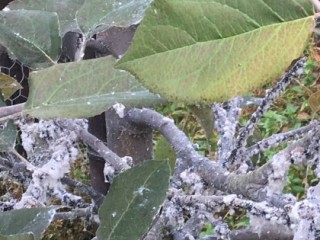
Woolly aphid is a sporadic pest of apple, which is sometimes present at low levels in orchards but only increases to cause problems in some years. Damage is expected to occur in years after warm winters when aphid colonies increase in early summer and spread onto extension growth. The entire life cycle is passed on the host tree.
Earwigs, ladybirds and the parasitic wasp Aphelinus mali are important natural enemies of woolly aphid and usually regulate populations to below damaging levels.
Artificial refuges should be provided for earwigs in orchards where woolly aphid is a problem and the use of pesticides harmful to earwigs and other natural enemies should be avoided.
The aphid itself is brown to greyish purple but is easily recognised as it produces conspicuous secretions of white woolly wax.
Orchards should be inspected for the pest (i.e. for the colonies that produce conspicuous masses of white woolly wax) at the end of blossom, in June and again in mid-summer.
The June assessment is critical. At least 25 trees per orchard should be inspected. If one or more trees in the sample has woolly aphid, in the extension growth, treatment with an insecticide is justified.
Control
- Flonicamid (Mainman) is specifically recommended for control of woolly aphid on apple.
- Flonicamid (Mainman) is a good choice because it is selective, has low toxicity to natural enemies and is partially systemic.
- In recent years however, woolly aphid has become increasingly difficult to control with flonicamid and all other materials. Where all other products are failing to gain control, the best choice of product is spirotetramat (Batavia) which is approved on apples for controlling sucking insect pests and gains good control of woolly aphid. It must be applied after flowering and works best when pests are moving from brown wood to green tissue. It will prevent population build-up but does not offer pest ‘knockdown’.
- Fatty acids (Flipper) has an EAMU approval on apples for controlling aphids and has increased the control options available should growers prefer to reserve other insecticides for control of pests later in the season. It is known to complement the use of Batavia as it provides quick ‘knockdown’.
- Use of synthetic pyrethroids, which are harmful to natural enemies, should be avoided.
- Higher volume sprays are likely to give best results.
Insecticides approved for use on apple which are recommended to control woolly aphid or offer some incidental control when applied to control other pests
| Choice of insecticides – efficacy factors | |||||
|---|---|---|---|---|---|
| Active ingredient | Trade name (examples) | Class | Selectivity | Approved for control of | Safety to Typhs |
| acetamiprid | Gazelle | neonicotinoid | broad-spectrum, systemic | Aphids | safe |
| deltamethrin | Decis Forte etc. | pyrethroid | broad spectrum | Aphids, apple sucker, capsids, codling & tortrix moths, sawfly | harmful |
| fatty acids | Flipper (EAMU 3419/19) | bioinsecticide | broad spectrum | Aphids, blossom weevil, two-spotted spider mite | unspecified but generally safe in IPDM programmes |
| flonicamid | Mainman | chlordotonal organ modulator | selective | Aphids and woolly aphid | safe |
| maltodextrin | Eradicoat Max | polysaccharide | broad spectrum | Aphids, spider mites | harmful |
| spirotetramat | Batavia | tetramic acid derivative | selective | Sucking insect pests | unclassified |
| Choice of insecticides – Safety factors | |||||||
|---|---|---|---|---|---|---|---|
| Hazards | Harvest interval (days) | Max. no. sprays | Buffer zone width (m) | ||||
| Anticholin-esterase? | Humans | Fish & aquatic life | Bees | ||||
| acetamiprid | no | u | t | u | 14 | 2 | 20 |
| deltamethrin | no | h, i | ed | d | 7 | u | 50 |
| fatty acids | no | h, i | h | u | 0 | 8 | 20 |
| flonicamid | no | u | h | u | 21 | 3 | sm |
| maltodextrin | no | i | d | d | 0 | 20 | sm |
| spirotetramat | no | h, i | t | d | Start of ripening | 2 | 10 |
| h=harmful, i=irritant, d=dangerous, ed=extremely dangerous, t=toxic, c=closed cab required for air assisted sprayers, sm=statutory minimum of 5 m for broadcast airassisted sprayers u=uncategorised/unclassified/unspecified* approval for use and storage of all products containing nicotine is allowed only until 08 June 2010 | |||||||
Control in organic orchards
In organic orchards where the pest is often troublesome, emphasis should be placed on cultural control measures such as the provision of artificial refuges for earwigs and, if practicable, physical destruction of colonies in spring.
- High volume sprays of fatty acids should be applied when damaging infestations develop.
